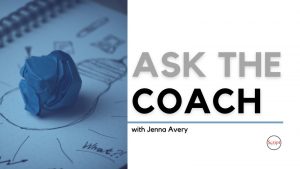
by Jenna | Dec 17, 2022 | ScriptMag Articles
In this month’s “Ask the Coach” article, I’m responding to a question about how much to develop a story before starting to write pages.
In this article, I talk about screenwriter Jeff Howard’s take on the value of outlining and developing a story, particularly for screenwriters, including being able to:
- Get back into a script more readily if life interrupts
- Meet contractual obligations to outline once working professionally
- Layer a story more effectively (easier to do at the outline stage)
- Maintain a consistent tone throughout the entirety of the script once you’re writing pages
My ultimate answer to the reader asking the question was: Yes, do the development work first, along with my reasoning based on their specific question and a recommendation on how to proceed.
It’s always tempting to want to skip over the hard part of solving those issues and just writing what you know so far, but you may well be writing yourself into a corner.
Photo by Ron Lach

by Jenna | Oct 14, 2021 | ScriptMag Articles
Welcome to the latest installment of my “Ask the Coach” column on Script Mag!
This month’s question is about fleshing out a story:
“My problem is, I grew up writing short stories, and now I am trying to write a screenplay. I ‘finished’ my script, and if it is true as they say that one page equals a minute of screen time, I have a movie that is roughly a little over 45 minutes. How do I expand my script without making it boring with just a lot of filler?”
Great question. Assuming you’re writing a feature, yes, 45 pages is short. In your shoes, I’d first focus on making sure I have a story with strong enough legs to last a full feature length, then, I’d dig into the specifics. Let’s discuss. [more…]
The big idea here is to look for ways to deepen the experience you’re creating for your audience, taking them on a powerful journey through the eyes of your primary characters.
Photo by Ron Lach from Pexels

by Jenna | May 24, 2021 | ScriptMag Articles
Welcome to the next installment of my “Ask the Coach” column on Script Mag!
This month’s question is about getting past feeling stumped and how to find an “idea person” to help make that happen:
“My writing style is that I get an idea and start writing to see where the story goes. I don’t do outlines. I’ve gotten ideas for stories from thinking up a name, or a killer last line comes to me, or from a writing prompt. I’ve written complete novels from those particular starts. A few of those I set aside for months (or years) before the idea for where to take the story comes to me. On one I’m working on now, I’m about 10,000 words in and stumped. I need an idea person. My question is: are there idea people who can take your progress and give you thoughts for where the story should go? I write really well if I have a direction to go. I don’t need someone to write the story for me, I just would love a shove in the right direction.”
I love the many rich layers in this question. Let’s dive in.
To start, there absolutely are “idea people” out there. From writing coaches to story experts to script mentors, you can find someone to help you tackle story problems and figure out what comes next. Sometimes it’s incredibly helpful to have someone to bounce ideas off of and get input from to help us move past the places we get stumped.
And I want to plant the seed that this may be a place to grow your structure and development skillset as well. Even if you’re not a writer who likes to outline, you may still benefit from sorting out the big moves in your story so you can write toward them as you pants your way through your actual writing.
[more…]
Image by Pixabay from Pexels

by Jenna | Oct 12, 2016 | Writing Articles
In a recent post I wrote about what "counts" as writing. I promised to share some of the story development steps I take before I'm willing to begin writing actual new pages; hence this post. This is a work in progress for me; I'm constantly working to hone and improve my writing skills, so I'm sure it will continue to evolve as I evolve as a writer.
Here's what I currently like to have before starting to write, in approximate order:
- Goals, Motivation, and Conflict (GMC) for Main Characters: The goals, motivation, and conflict for each of my primary characters so I stay in touch with what they're doing, why they're doing it, and what gets in their way over the course of the story. (This link will take you a more detailed article about GMC.)
- Character Profiles: I write character profiles for my primary and secondary characters detailing their personality traits, flaws, character arcs, and more. (This link takes you to the same place as the one above, where you can also download a free character profile template that includes GMC.)
- Logline: A twenty-five word summary of the story, including its best hook.
- Premise Line: A longer summary of the story, using Jeff Lyons's method for mapping the core structural story elements to a premise line template.
- Theme and Message: What's this story about? This is one of those things I'm usually guessing at when I first start —it often doesn't become clear until I've written one or more drafts, but I like to take a stab at it before I begin. More on this in the future.
- Internal and External Content Genres: I like to use Shawn Coyne's The Story Grid* to get clear on the external and internal content genres of the story to help me make sure I'm staying in touch with the theme and intent of the story I'm aiming to tell.
- Key Story Values: I also like Shawn's approach to identifying the key values at play in the story (as indicated by the content genres) and make sure (to the extent of my current abilities!) that I also understand their gradations along the spectrum from positive to opposite/contrary to negative/contradictory to the negation of the negation that I'll be exploring over the course of the story.
- Primary Plot Points: I detail my primary plot points, using a cobbled-together version of the many variations I've learned over the years. These tie in well with the mini-movie method I use (developed by Chris Soth) and help break a story down into smaller chunks.
- Opening
- Inciting Incident
- End of Act I, Lock In, Plot Point #1
- First Pinch Point
- Midpoint
- Second Pinch Point
- End of Act II, Cave Moment/All Is Lost, Plot Point #2
- Crisis
- Climax
- Resolution
- Plot Backstory: I like to write out a summary in prose of what's happened leading up to the story. Who was doing what before we enter this story world's timeline?
- Scene by Scene Outline: I also like to have a scene by scene outline before I start writing scenes. I identify their location (with a slugline, since I'm writing scripts), the essence of what happens in the scene, and several other elements. I use a scene template that I'll share with you at some point.
- Treatment/Synopsis (Optional): I may also write a treatment or synopsis for the story, knowing it will likely change as I write the actual story, just to give myself a little more guidance about what happens. Usually I'll do this before a scene outline.
- Query Letter (Optional): Sometimes I'll even take a stab at writing a query letter for the project to help me identify the hooks for the story and what to focus on building strongly.
- Timeline or other organizing structural tools (Optional, if the story demands it): If needed, I'll create a timeline for the project (particularly valuable for time travel stories!) or create other project specific organizational systems if the story requires it. This is one of those gut-level things for me.
Once I have all these pieces of the puzzle assembled, that's when I'll feel more confident about starting pages. Sure, some may change, but it gives me a road map and greatly streamlines the writing process for me. I'm also finding that I'm asking myself to stay longer and go deeper with each element, in order to feel more solid about it before diving in.
What do you like to have before you start writing pages, if anything? Or are you more of a pantser when it comes to writing pages? I'd love to hear about your approach in the comments.
* Affiliate link

by Jenna | Oct 2, 2013 | Writing Articles
 In the third and final session of my interview series with Enneagram and story development expert Jeff Lyons (recordings no longer available), we talked about "Bridging the Gap from Motivation to Structure With the Enneagram." Today's post is a recap of what we discussed.
In the third and final session of my interview series with Enneagram and story development expert Jeff Lyons (recordings no longer available), we talked about "Bridging the Gap from Motivation to Structure With the Enneagram." Today's post is a recap of what we discussed.
His process for "bridging the gap" from premise line to character to story is quite fascinating, and he illustrated it using a breakdown of The Great Gatsby according to the Enneagram.
Bridging the gap
Here's an overview of the process:
- Step 1. Write out your premise line and log line.
(See the last post for more on premise line development.)
- Step 2. Define the moral problem that best illustrates the story's premise line.
(In Gatsby, Nick focuses on trying to fit in and be liked, he isn't being his truest self, which is a form of lying.)
- Step 3. Look for the Enneagram type that best represents the motivations (not behaviors) of someone with that moral shortfall.
(Nick most aligns with the Enneagram type 9.)
- Step 4. Study the integration and disintegration points for that type to identify what the character is capable of and what they're greatest opponent might be.
(Points 3 and 6, respectively.)
- Step 5. Explore the entertaining moral argument possibilities between those two types.
(Can you succeed and achieve without giving up your soul?)
- Step 6. Brainstorm about the communication styles, "pinches", and blind spots of each of those two types.
(Nick has various challenges that Gatsby can poke at and wreak havoc with.)
- Step 7. Map your story using these Enneagram components and correlate them with the visible structure components we discussed last time.
(This includes the protagonist, moral problem, chain of desire, focal relationship, opposition, plot & momentum (midpoint complication, low point, and final conflict), and evolution/de-evolution and is the more complex step where the story is broken down into a greater level of detail).

Your turn
Have you considered using the Enneagram in your story development? Will you consider using it in the future? We'd love to hear your thoughts in the comments.
Warmly,

You may also be interested in:
Image by © Royalty-Free/Corbis







 In the third and final session of my interview series with Enneagram and story development expert Jeff Lyons (recordings no longer available), we talked about "Bridging the Gap from Motivation to Structure With the Enneagram." Today's post is a recap of what we discussed.
In the third and final session of my interview series with Enneagram and story development expert Jeff Lyons (recordings no longer available), we talked about "Bridging the Gap from Motivation to Structure With the Enneagram." Today's post is a recap of what we discussed.